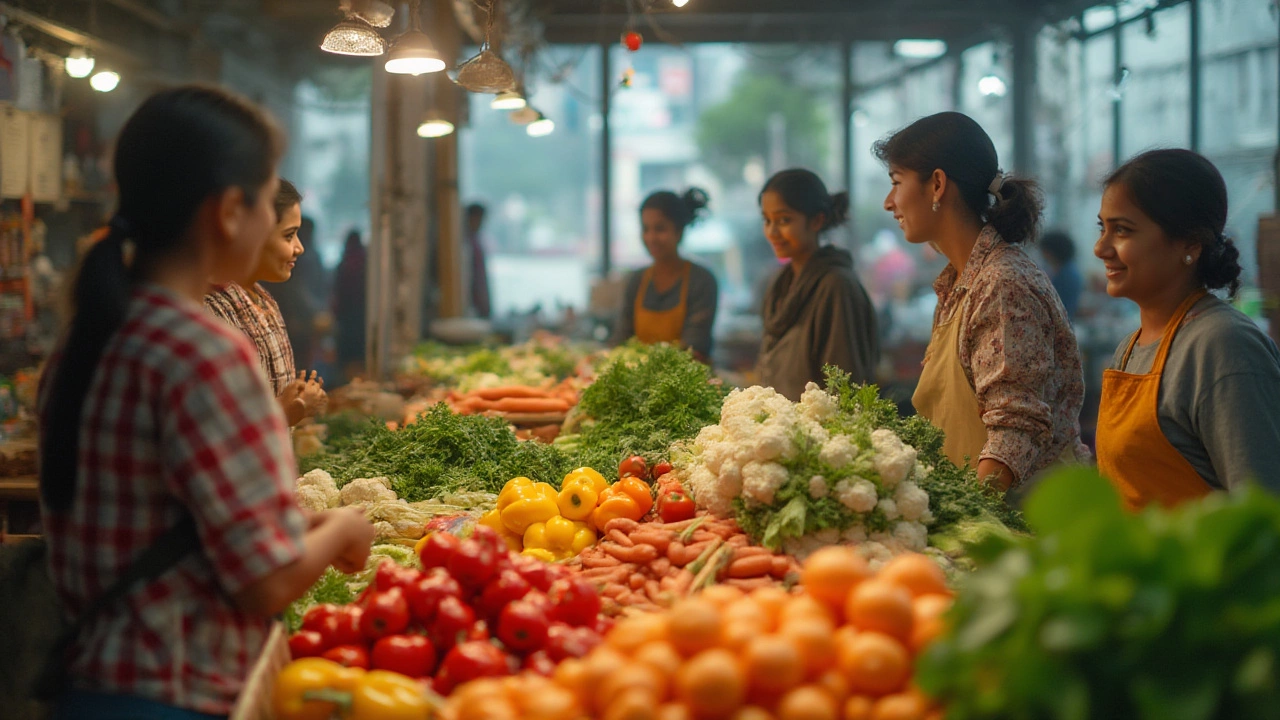Ask any farmer in India who’s tried a bunch of different crops which vegetable puts the most cash in their pocket, and you’ll get a range of heated opinions. Some say it’s all about tomatoes, others argue for chilly peppers or exotic mushrooms, and old-timers will quietly nudge you toward okra or cucumbers. The thing is, profits aren’t just about what’s easy to grow or quick to harvest—they’re about demand, market timing, yield per acre, cost to produce, risks of disease or pests, access to buyers, and, often overlooked, your own location and connections. The answer isn’t as simple as tossing a seed in the ground and hoping for a money tree. The best way to find out? I spent weeks looking at what farmers, agri-business experts, and the Indian government say about high-profit vegetable farming.
The Most Profitable Vegetable Crops: Numbers, Trends, and Myths
Let’s cut through the hype—profits are data-driven. Take tomatoes, for example. According to the Ministry of Agriculture & Farmers Welfare data from 2023, tomatoes are India’s third-most cultivated vegetable, but they’re also one of the most volatile in terms of price. A good harvest season and prices plummet; a blight or freak storm ups the rates, but only for those lucky enough to still have a crop. Yet, despite those risks, tomatoes still pulled in average net profits of ₹90,000 to ₹1,25,000 per acre for farmers with access to cold chains and local markets last year. That’s noteworthy, especially when compared to staples like potato or onion, where profit is often half that amount after input costs—according to data from the Indian Council of Agricultural Research (ICAR).
But here’s where most new farmers get it wrong: following the crowd. When everyone swings toward the same crop because of the headline profits last year—say, chillies spiked due to heavy rains in Andhra Pradesh or okra led with big export orders—prices drop next season as supply soars. For example, the chilli boom in Guntur saw average prices fall from ₹140/kg to ₹58/kg within two seasons. Supply glut kills the margins. Savvy farmers often play a long game, rotating cash crops based on local climate, soil, and upcoming market gaps.
You’ve heard folks say that exotic “niche crops” like mushrooms or sweet corn are gold mines. There’s truth here, but only for those with access to high-end retail buyers, restaurants, or urban markets. Button mushroom farming—hugely popular in Haryana and Himachal Pradesh—can net a whopping ₹2.5 to ₹3 lakh per acre per year if you have a controlled environment setup and reliable customer base. But the startup costs for construction, climate control, substrate, and spawn can eat up savings fast. These models thrive in peri-urban fringes where logistics make direct sales easy, and less so in remote villages unless you have bulk contract buyers.
To really compare, here’s a look at average income figures per acre for top vegetables in India (based on NABARD, ICAR, and state horticulture board data, 2024):
| Vegetable | Avg. Annual Yield (kg/acre) | Avg. Market Price (₹/kg) | Net Profit (₹/acre) |
|---|---|---|---|
| Tomato | 35,000 | 10-18 | 90,000 - 1,25,000 |
| Green Chilli | 12,000 | 20-60 | 70,000 - 1,20,000 |
| Mushroom | Variable | 80-150 | 2,50,000 - 3,00,000 |
| Okra (Lady Finger) | 7,000 | 16-35 | 60,000 - 95,000 |
| Cucumber | 18,000 | 12-25 | 65,000 - 1,00,000 |
| Capsicum (Bell Pepper) | 10,000 | 40-80 | 1,20,000 - 1,80,000 |
So where does that leave us? The clear winners for the highest potential profit in the Indian context are mushrooms and greenhouse capsicum—if you’ve got land close to major cities and some capital. For open field and ordinary settings, tomato is the king of high-volume, high-demand gambling. If you’d rather aim for stability, go with okra or cucumber, which rarely sees massive price dips due to steady year-round demand.

Hidden Influencers: Climate, Disease, Technology, and Local Demand
If you’ve only looked at numbers, you’re halfway there. The other half is understanding what can slam your profits unexpectedly: climate changes, new or stubborn diseases, and rapidly shifting local demand. In states like Maharashtra and Karnataka, heat waves in the last three years have crashed tomato and capsicum harvests, while new fungal pathogens up North knocked out rows of cucumbers. Farmers who invested in drip irrigation, heat-tolerant varieties, and even simple polyhouse structures fared far better, keeping sizes and yields up when neighbors wilted.
Tech is changing the vegetable game. Farmers with access to WhatsApp groups connected to nearby mandis or agri-tech startups know price trends even before the middlemen roll in. I spent an afternoon with rooftop gardeners from Pune who teamed up with a startup to sell cucumbers, spinach, and leafy veggies direct to housing societies—outselling larger field operations just by riding that hyperlocal demand and freshness. That’s adaptability most rural farmers struggle with unless they have tech-savvy family or good cooperatives.
Diseases and pests don’t just knock down yields—they can wipe profits clean off your books. Okra is notorious for the yellow vein mosaic virus. Tomatoes catch early blight and fruit rot if monsoon catches you unprepared. Mushrooms are risky—humidity swings mean one bad week can provoke a mass contamination. Farmers with net houses, anti-virus seeds, and regular pest monitoring reduce loss rates by up to 50%, according to field data from the Indian Institute of Horticultural Research (IIHR, Bengaluru).
Let’s not ignore locality. In Tamil Nadu’s Coimbatore belt, okra fetches much better prices due to regional preferences in sambar and poondu kuzhambu, so profits beat tomato or even capsicum in that zone. Punjab’s proximity to Delhi gives capsicum and cauliflower an edge due to easier logistics and bigger buyers willing to pay for fresher produce. Before planting, it’s smart to walk local wholesale yards, check what’s selling, and talk to traders for price history.
If you ask successful Indian vegetable farmers their secret, they talk more about building networks—linking up with local traders, cold storage operators, or agri-entrepreneurs—than about any one ‘magic crop’. The farmers who survive wild demand swings are the ones with a backup plan: maybe selling direct to markets, forming small farmer groups, or growing a mix each season to spread risk.

Secrets to Boosting Profit: Smart Choices, High Value Varieties, and Timing
The classic mistake? Picking a vegetable just because it’s topping the charts this year. If everyone in your village is doing tomato and you join in, prices crash the minute harvest season peaks. The “zig when others zag” principle pays big here. If you can spot a small gap—for instance, unusual veggies like broccoli, Italian beans, or organic beetroot for upmarket buyers—you can get much better margins even on smaller land size.
Crop diversification isn’t a buzzword, it’s insurance. Blending fast 30-day crops like spinach or coriander between tomato or chilli rows keeps money flowing, lets you catch surprises—like a sudden price boom in a side crop. Polyhouse and net house farming—now supported by government subsidies up to 50% in several states—makes year-round bell pepper or cucumber a genuine option. Costs up-front are stiff (up to ₹18 lakh/acre for full automation), but returns are far more stable, with less up-and-down in prices and predictable supply for big buyers.
- Pick the right hybrid: Yields on regular tomatoes are beaten by hybrid seeds like Arka Rakshak and Pusa Rohini, which fetch more and tolerate adverse weather.
- Smart scheduling: Staggered planting (instead of all at once) lets you catch higher prices as off-season or festival demand spikes—Navratri and Diwali usually see surges for certain veggies.
- Soil health pays: More profit comes from less money spent on chemicals. Farmers resting their land with cover crops or vermicompost report fewer pests after two seasons.
- Pack and present: Simple steps like grading, sorting, and using small crates (instead of gunny sacks) fetch 10-20% higher rates at APMC mandis, as traders trust your produce arrives undamaged.
- Sell where it matters: Linking up with urban aggregators—Big Basket, FreshToHome, or Hyperlocal Markets—often brings in better prices for consistent high-quality produce.
Don’t ignore the bottom line. Water is the real currency in Indian vegetable farming now, especially with unpredictable monsoons and heat waves. Drip systems, mulching, and water harvesting can triple your survival odds for profit, particularly for thirsty crops like tomato and cucumber. Also, start small and try the market with half an acre before betting the farm. You’ll make more by learning mistakes cheap, not expensive.
The bottom line? There’s no universal “money crop” that works for everyone—successful Indian vegetable farmers play to their strengths, adapt, and never rely on a single crop or customer. The most profitable vegetable depends on your land, market links, risk-taking appetite, and ability to spot opportunity—or trouble—ahead of the curve.

